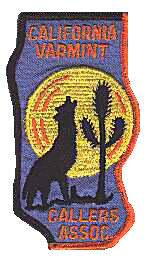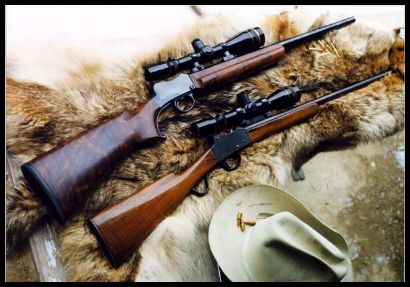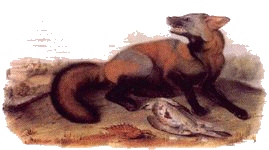|
The California
Varmint Callers Association
The first varmint hunting site on the net! The California Varmint Callers maintains this webpage for the benefit of all varmint and predator hunters.
|
||||||
|
|
MORE FROM UNCLE JOHNNot being a computer freak, I never get feedback on what I have said except through a friend in California. So far, the feedback has been very positive, and I thank you. I am sure that my friend has withheld some negative responses regarding my lack of interest in the .223. Oh well, any old brass bottle behind the bullet will make it go bang. And what a dull world it would be if we all liked the same thing! I know that most of you in the California Varmint Callers Association must be primarily interested in coyote calling. You have the opportunity to observe a primary aspect of coyote behavior: hunting food.
As a professional fur taker in the Halcyon days of the modern fur trade, we took coyotes (and fox) any way we could get them. We took any fur we could get, which in 1973 produced over 12,000 dollars worth of income in two months. We had to know our critters! This is not a lesson in predator behavior, just a compilation of stories you might enjoy. I had hunted fox (there were few, if any coyotes in the Midwest at the time) from the time I was about ten years old. In those days, we cut a fresh track in the snow early in the morning and we pushed that fox until we wore him down and got a shot. Sometimes this would take all day. You could tell that things were coming to a head when you found the first spot where he laid down. These spots would occur more and more frequently until finally you would jump him. Sometimes, if you watched, you would get a shot at a different sleeping fox up on some sunny hillside, as you tracked your quarry. The fox you were tracking would try lots of tricks. For instance, you might loose the track in a confusion of other tracks, start home and then find that the fox you were tracking got around you and was walking in YOUR OWN boot tracks, the way you had come. Sometimes they would jump onto a large tree limb and leap into other tracks. There was no end to the tricks they would use. One day in the late fifties, I had spent the whole day unsuccessfully tracking one fox. I was leaning against my outfit on the road, near sundown, laughing, when a farmer stopped by to ask what the heck I was doing. I told him that the fox I had tracked all day was up in a tree about a half-mile away, and we were laughing together at me. He wouldn't believe a red fox could be up in a tree, until I handed him the glasses. The farmer enjoyed the joke too.
I called a friend and we again set out for that fox. I spotted him in the little draw where I had gotten hurt. My friend went around the backside of the hill. I fired a shot and missed. The fox lit out like a rocket and was in mid air, jumping the wire exactly in the spot where I had gotten hung. My friend folded him in mid air with one shot from his Remington .222. So ended the story of that wise old fellow. In those days, we called fox at night with mouth calls. It was cold as hell, and I wore a WWII leather, wool, fleece lined high altitude flight suit. It had 13 zippers, just in the pants! We bought flashlight holders for bicycle handle bars, cut them and re-welded them, so that we could clip them to the bottom of 12 gauge barrels. We adjusted them to put the buckshot in the center of the light beam. The fox population began to decline in the '70's due to an influx of coyotes. At the peak of the fur trade, there were plenty of both. Trapping predators provides a broader view of their behavior. And remember, we hunted them along with the trapping. Our primary concern was money! We ran a trap line about 50 miles long in farm country. I took on a partner who specialized in water trapping. He more than paid the gas bill with mink, muskrat, coon, and some possum. I specialized in the high ground, taking very large, bold boar coon, coyotes, and fox. Water trapped coon are usually small and dark. Some of the open prairie coon weighed much over 30 pounds and were beautiful fur. Coyotes average 28 pounds, some up to 45. A hunter handles dead coyotes. I contended with very live ones several times each day. You may have no idea how dangerous they can be when caught. Once in 1973, a farmer called me to help him with his coyote problem in a remote hilly pasture region of southern Iowa. He had good coon hounds, and the coyotes were luring his dogs out and killing them. I chose a good backstop on a hill overlooking the farm, about a mile away. One has to use a backstop, some obstacle that keeps the critter from coming to the bait hole from the backside.
Late the next day, I found the largest coyote I had ever trapped, a 45-pound female, in the trap. She had beaten the bluegrass bare. I had a young lady riding with me. Rather than putting on a show with my pool cue, I quickly finished the animal with my revolver. I commented that something was wrong with this set. No backstop. What had I used? The day before, she had watched me set the trap. She pointed out that my backstop had been a ten-foot honey locust thorn tree. It was gone. The coyote had turned it into miniature toothpicks in about 15 hours. The black dyed steel trap was bright silver. Once my water trapping partner had gone for a day and paid for lessons from an expert predator trapper. He wanted to trap the "big" stuff. I asked what he had learned. One of the things was that you could never lure a coyote into a tight spot. Along our way, we passed an unusual formation of impenetrable multiflora rose, which formed a hollow ring about ten feet in diameter inside. There was a narrow "gate" on one side. I went in there and made my set, baiting with a mouse and scenting the highest tips of the bush near the entrance. We caught three coyotes in the next three days in that set. I advised my partner that the next time he wanted to get rid of some of his money, he could give it to me. We were hiking into a remote, snowbound trap in the middle of a large hilly pasture. We had a nice coyote in it, who was setting up quite a howl, unusual for a trapped animal. They are usually vocally quiet. Rather than shoot the critter, I walked to an old hedge row and selected a nice stick. I hazed the coyote into range and gave him a tap on the bridge of the nose. My partner grabbed him by the muzzle from behind and began to try and finish him cleanly. I got to laughing so hard I had to wander over the hill. My tears were freezing in the 30 below zero cold. When I staggered back, here was my partner, sweating like the fourth of July. He dared not let go. A coyote can tear you up very deeply and seriously in the blink of an eye. A professional trapper of high esteem nearly bled to death, here in Montana, from one slash, in a moment of attention lapse. I managed to pull myself together long enough to finish the deed. Sure glad my partner didn't let go while my leg was in range of the fangs. I would not have blamed him too much if he had. In regard to hunting the predators, it depends on the country you are in, i.e., the ranges involved, and whether you intend to save the fur. Some really like the .17 Remington. I do not like .17's for two reasons. Unreliable bullet expansion and they are hard to work with in reloading and cleaning. My favorite, that I have used for many years, is the 250/3000 Savage, and I also like the 22/250 which is just a necked down 250 Savage case. In the 22/250 I prefer a hard match bullet, like the Sierra 52 or 53 grain. If I want to really stop them in a spectacular fashion, no bullets beats the 50 to 55 grain Starke Red Prairie Varmint bullets. The .222 with good bullets is also a great one for slightly shorter range. It kills well out to 600 yards IF you are good enough with it to compensate for drop. That requires a LOT of experience. The poly tipped bullets are good, too, but I have not found them to be competitive with premium match bullets in accuracy. Guest article written by Uncle John and submitted by David Buchman. David can be reached at [email protected] If you would like more stories and dumb opinions, let David know.
|
|||||


 I went back
after that fox a few days later, after a heavy snowfall. I had to cross a
barbed wire fence, and old fashioned, rusty one with very long barbs. I walked
up to it in about a foot of snow and stepped over it. My forward leg found
no bottom on the other side, and I was flipped upside down, just hanging
there. A long barb was imbedded inside my upper thigh. This was trouble,
as I could have died there and not be found for a long time. I managed to
pull the Winchester Model 43 218 bee from my shoulder, laid it on the snow,
and got two hands on the wire. I was in great pain and bleeding badly. I
somersaulted over the wire, tearing my leg badly. Retrieving my rifle, I
hiked toward the nearest road, hoping some farmer would pick me up and take
me to my vehicle. I ended up walking a mile, and was blood soaked. I got
myself to a tiny village and found the old, retired doctor. He sewed me up
and asked how the hell I got hurt like that. I told him the story of the
fox, and he laughed so hard he could hardly hold the needle for my tetanus
shot. He was an old fox hunter, too.
I went back
after that fox a few days later, after a heavy snowfall. I had to cross a
barbed wire fence, and old fashioned, rusty one with very long barbs. I walked
up to it in about a foot of snow and stepped over it. My forward leg found
no bottom on the other side, and I was flipped upside down, just hanging
there. A long barb was imbedded inside my upper thigh. This was trouble,
as I could have died there and not be found for a long time. I managed to
pull the Winchester Model 43 218 bee from my shoulder, laid it on the snow,
and got two hands on the wire. I was in great pain and bleeding badly. I
somersaulted over the wire, tearing my leg badly. Retrieving my rifle, I
hiked toward the nearest road, hoping some farmer would pick me up and take
me to my vehicle. I ended up walking a mile, and was blood soaked. I got
myself to a tiny village and found the old, retired doctor. He sewed me up
and asked how the hell I got hurt like that. I told him the story of the
fox, and he laughed so hard he could hardly hold the needle for my tetanus
shot. He was an old fox hunter, too.
